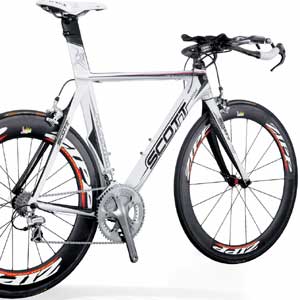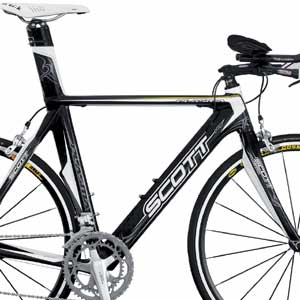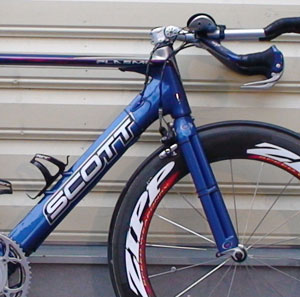Scott’s Plasma for 2008

A prospective retailer at a recent FIST clinic announced to me that, "We think we have Cervelo secured as our primary line. We're now considering what our second line ought to be; we're thinking about Scott."
My answer was this: "First, you need to decide whether your second line needs to be geometrically redundant, or complementary. If it's redundancy you want, then target Felt, or QR. If it's complementary then, yes, Scott is a good choice.
By "complementary" what I mean is that Scotts don't fit like Cervelos. A significant slice of those I fit would find, on balance, that Cervelo is a close geometric match with my sensibilities. Cervelos tend to fit a lot of folks quite nicely, and that's why they enjoy a nice market share in triathlon. Another slice of those I fit would be a better match for Scott.
On paper those two "slices" don't enjoy much overlap. But there are two things that make Scott a good bike for a wider audience than a simple perusal of the geometry chart would indicate. First, the bike's 76-degree seat angle — shallow by my standards — adjusts further forward than would typically be the case with other bike companies, because Scott's proprietary seat post hardware grants the saddle more forward movement relative to the seat tube centerline. (Here's a nifty trick: by swapping the left and right seat post hardware, you get an extra centimeter of forward saddle adjustability.)
The second helpful element is a change in handlebar spec from last year to this — on one of its Plasma models. All of last year's Plasmas had high-profile armrest aerobars from Profile Design which, in addition to the Plasma's tallish head tubes, made it hard to get the front of the bike low enough. View the pics of Ain-Alar Juhanson's Plasma on our write-up of that bike (the link follows below this article). Ain needs a stem that angles downward from horizontal, on top of the fact that his non-OE-spec Oval aerobars have a lower profile armrest than the stock Profile Designs that came with this bike in 07.
Yes, Ain has a lot of armrest elevation drop from his saddle (21cm), but he's also got 86.5cm of saddle height, which makes his drop not overly low, but exactly what one would expect from a rider his size riding his seat angle (my "seat angle formula" perfectly predicts Ain's 21cm drop at 78 degrees of seat angle and 86.5cm of seat height).
This year Scott has changed its spec on it's higher end LTD to Profile Design bars that have significantly lower armrest elevations vis-à-vis the pursuit bar. But, the Plasma Pro keeps its high profile armrests. Bottom line, if you're a Plasmaphile or think you might turn into one, you'll need to make a PDF of this article (print => PDF => save as PDF) and attach it to the email you send to your Scott-stocking LBS prior to your visit to his shop along with the note, "Please read, and report back when you're ready for my visit to potentially buy one of your wonderful and sexy Plasmas. By 'ready' I mean that you have low-profile aerobars for possible replacement, along with horizontal-extension stems, and low-profile headset top caps in hand."
All that established…
The Plasma has a variety of frame elements that are quite unique and admirable. Those who ride these frames to whom I spoke comment favorably as to its robustness in the lateral plane, yet to its lightness of weight, largely due to its extended seat mast. The frame seems to have most of the requisite elements required to grant it reasonably good aerodynamics, specifically a somewhat faired rear wheel and an extended seat mast with a shape that appears to allow for a nice airflow. While the fork looks to have benefited from invested thought, I have no knowledge of its aerodynamic qualities, and have no good basis on which to form an opinion. The down tube is relatively thin, but with a minor diameter of 35mm it's 5mm to 7mm fatter than what might be aerodynamically optimal.
I was very pleasantly surprised when I rode this bike at the ease of which the saddle tilt was executed through Scott's proprietary seat post hardware. That hardware consists of two bolts, and the front bolt acts as a pivot around which the saddle rotates, that is, the saddle tilts up or down around that pivot, and the rear bolt locks the saddle down.
The seat post cap grants you about 2cm of wiggle room. You can cut the seat mast as much as 2cm too short and the post cap can successfully and safely be raised that far above the miter. Scott gives you a little mitering tool that allows you to cut your seat mast squarely. If you manage to cut it too short anyway, there is a second seat post cap that's longer, and fixes your mistake. Perhaps some bike boxes might not easily accept a Plasma and its long seat mast, but I don't perceive that as a major issue. Big Juhanson seems to get his bike from continent to continent.
The CR1 Plasma is a single frame model that is available with two different groupkits, granting the user a pair of price points from which to choose. It's available in six sizes, all in 700c.

The CR1 Plasma Pro sells for anywhere between $4200 and $4600, depending on the retailer (we see the Plasma Pro at that lower price online here). This is a bump of about $400 from the prior year. The kit is largely Shimano Ultegra, with Mavic Cosmic Elite wheels, Profile Design Cobra T2+ bars and QS2 brake levers. The saddle is a ready-to-ride Fizik Arione Tri 2.
My beef with this bike is the same as it was last year: the Profile Design T2 Cobra is a wonderful aerobar, but the wrong one for this bike. Profile Design makes a wonderful new Carbon Stryke that would price out very nicely for Scott, and would place the armrests flat down on the pursuit bar — much needed on a bike with head tubes this tall. This means you will probably have to change the aerobar unless: 1) you think you should fit aboard your bike differently than I think you should fit aboard your bike; 2) you specifically have long legs and a short torso; 3) Scott has a change of heart and (even at the last minute!) decides to spec the Carbon Strykes.
The CR1 Plasma LTD (pictured at the top of this article) commands the higher price, just north of $7000. It's Dura Ace throughout, with Zipp carbon 360 and 420 rims on the front and rear respectively. These wheels accept tubular tires, and Conti sew-ups are provided. What this means is, these are your race wheels (no training on these babies).
The bike is (happily!) spec'd with Profile Design's Sonic Stryke aerobars, which is a perfect spec match. If you want to ride a Scott Plasma, this is the way to ride it.



